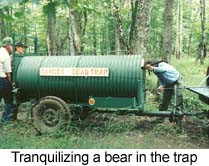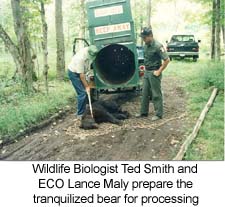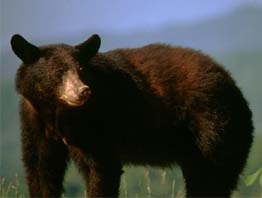Black bears present a special challenge to Conservation Officers. Officers, whose patrol sectors are populated by bears, must often deal with unique situations created by bears, or by the people living, camping, or hunting in bear country. We are confronted with bears wandering through campgrounds and stealing coolers, just like Yogi. When the coolers are not readily available, bears will sometimes search through tents or campers for food. These searches are seldom carried out in a neat or orderly fashion. We deal with bears breaking into camps, garages, chicken coops, pig pens, barns, and all manner of out buildings, even the occasional home. The bears, surprising as it may seem, are easily dealt with in most cases. The people interacting with bears are another matter entirely. To handle bears we have an arsenal of weapons including pepper gas, rubber bullets, rubber buckshot, shell crackers, tranquilizer guns, and culvert traps. All we can use with the people is education, an infinite amount of patience, and the occasional invitation to court.
Each spring brings new beginnings. The trees begin to leaf out, the flowers bloom, the blackflies hatch, and the bears emerge from their dens. As you can well imagine, they are very hungry after a long winter’s fast and, unfortunately for us there is not an overabundance of food available in the woods at this time of year. This generates the initial onslaught of bear problems. Not finding enough to eat in the wild, the bears turn to more civilized areas to shop for groceries.
For years Adirondack bears headed to the town dumps and foraged through the garbage for epicurean delights. Over time almost all of the open landfills have either closed, or been converted to transfer stations. Bears, being as intelligent as they are, discovered that, although there was no longer any garbage at a central location, there was plenty of it being stored in various places awaiting a trip to the transfer station. Those places included backyard sheds, garages, back porches and other locations very close to human habitation.
 When we were moving into our house in Cranberry Lake, my wife inquired about some muddy paw prints on the garage door and a huge log propped up against it to keep it closed. “Just some bear tracks”, I mumbled, hoping she wouldn’t pursue the issue. We had first moved to the Adirondacks in 1973 and had lived there for many years without experiencing bear problems. Of course the dumps were open then, and that’s where the bears concentrated their search for food at that time and not in residential backyards.
When we were moving into our house in Cranberry Lake, my wife inquired about some muddy paw prints on the garage door and a huge log propped up against it to keep it closed. “Just some bear tracks”, I mumbled, hoping she wouldn’t pursue the issue. We had first moved to the Adirondacks in 1973 and had lived there for many years without experiencing bear problems. Of course the dumps were open then, and that’s where the bears concentrated their search for food at that time and not in residential backyards.
“What’ya mean, bear tracks?” I didn’t realize it at the time, but my first customer in my public relations campaign for bears was my wife. She has since seen many bears, had quite a number of them at our home, usually in culvert traps, and even assisted me in the trapping operations.
One of the first bear complaints that I recall handling was at the Boni homestead, located at the end of a dead end road in the hamlet of Oswegatchie. The Bonis, an elderly couple, had been visited by a bear, which broke into their back porch through a window screen and had stolen two pies that Mrs. Boni had set out to cool. I couldn’t help thinking about cartoon characters and smile to myself as Mrs. Boni explained what had occurred. Mr. Boni stood quietly by while his wife gave me all the details in a very animated dissertation. She talked rapidly as she pointed out exactly where the bear had emerged from the woods and strolled across the back yard, and where it had paused briefly to demolish a stuffed bear lawn ornament that Mrs. Boni had just recently purchased.Without missing a beat, she inquired as to whether this was normal behavior. I started to answer, but Mrs. Boni quickly asked if I wanted coffee. Mr. Boni stood quietly by the back door smoking his pipe. She headed back to the house, continuing her discourse as she went.I followed. Mr. Boni continued to puff on his pipe. As we went through the back porch, the scene of the crime was again pointed out to me by Mrs. Boni. She reminded me of the original position of the pies and again showed me the torn screen. Mr. Boni followed us into the kitchen.
“You want coffee, Pa ?”, Mrs. Boni inquired. Her voice was startling inside the kitchen.
It looked like Mr. Boni was going to say something as he sat down at the table, but Mrs. Boni placed a cup of coffee in front of him, so he just set his pipe aside and picked up the cup. We listened politely and sipped our coffee as Mrs. Boni went through the entire story again. She would ask questions occasionally, but it was not necessary to answer. She didn’t seem to have the time to wait for answers. Mr. Boni and I continued to sip our coffee and it was very good.
With a final dramatic flourish, Mrs. Boni reached the end of her story again and headed for the refrigerator. She reached up on top of it and turned around holding a pie plate for me to see. It was only slightly bent, but there were a number of holes about the size of a dime through the middle of it. Mrs. Boni had become quiet and I could see that she was quite agitated.
Taking advantage of the silence, Mr. Boni leaned towards me and said quietly, “Yep, that bear sure pissed Ma off when he bit through her pie tin.”
Further inquiry revealed that the bear had been a frequent visitor to the Boni homestead. The old couple had numerous cats, for which they regularly left food outdoors. They also had many bird feeders. The bear had been stealing cat food and birdseed all summer, but it wasn’t until he mutilated the pie tins that he was considered a nuisance.
Mr. Boni passed away a couple of years ago, but, prior to that, I had trapped and removed a couple of bears from their backyard, and had consumed quite a bit of coffee at their kitchen table. I’m sure he and I must have had some other conversations, but the only thing that sticks in my mind is the comment he made about the pie tins during my first visit to his home.
________
Not all bear problems are as easily dealt with. The problems in the hamlet of Windfall, just a few miles north of Cranberry Lake, kept me up nights for two summers. Windfall is a tiny community containing one drinking establishment, about a dozen year-round residents and numerous hunting camps and summer cottages. Phone calls began to trickle in from camp owners, who would show up on a weekend and find that their camps had been broken into and ransacked by a bear. If you’ve never seen what a camp looks like after a bear visit, believe me, it is quite a shock to the uninitiated. Especially if the first time viewer is the owner of the property in question.
Bears typically gain entrance to an unoccupied camp by breaking through a window. Once inside, they conduct a very thorough search for foodstuffs left behind by the camp owner. They most often tip over refrigerators and stoves, doors will be ripped off cabinets, and sometimes the cabinets are ripped off walls. Containers are punctured, torn apart, or broken, depending on the material from which they are constructed. The contents of the food containers will be found spread throughout the camp in prodigious quantities. Flour, peanut butter, honey, molasses, butter, cereal, milk, beer, and whatever else the bear finds inside will end up smeared over everything. For good measure, the bear will occasionally tear up any stuffed furniture too.
When they finally accomplish their mission, the bears indulge themselves in a ritual of departure that is part of Adirondack folklore that any longtime mountain resident can relate. For reasons unknown, and possibly just to add insult to injury, the offending bruins never seem to leave the same way they entered. They will almost always break a second window to make their escape.
___________
The first summer I investigated twenty-four separate camp break-ins, some worse than others. In two instances the bear entered the camp by tearing the siding off the camp, breaking wall studs and interior paneling, and climbing in the resulting hole in the side of the camp. Aside from the break-ins, there were numerous bear sightings and attacks on garbage cans. During the late hours on a warm summer night, I would patrol slowly through the village and encounter camp owners wandering around with loaded shotguns. We would have lengthy discussions on the wisdom of this practice, but they were seldom deterred.
After many weeks of frustration, the offending bruin was finally captured in a culvert trap. I transported the bear, still in the trap, to the Moose River Plains Wilderness Area. Being the first week of early bear season, I encountered a number of hunters on my way into the area. The curious and the desperate began to follow along, and, by the time I reached a suitable release site, I had gathered a sizable entourage of onlookers with guns. I released the bear and held back the crowd to give the bear a head start and then I departed. I doubt the bear had much trouble evading that bunch.
 The second summer of bear problems was very similar, but was definitely a different bear. This one was somewhat smaller than the previous bear. After a considerable number of break-ins, this bear attacked a camp on the shore of Cook’s Pond. Upon investigating this incident, I could come to only one conclusion. It appeared that the bear attempted to gain entrance to the camp through a window in the rear door of the camp. When it broke the window, it was apparently injured rather severely as there was a significant amount of blood on the door and the immediate area. I theorize that the bear became angry at this point because it then carried out a very methodical attack on the camp. Many of the windows were broken, the siding was clawed, and corners of the camp were clawed and bitten. No exposed portion of the camp was ignored, and everywhere the bear attacked it left evidence that it was bleeding profusely. The bear never did gain entry to the camp, and was never heard from again. There were no more bear problems in Windfall that summer. It seems likely that the bear died of its injuries.
The second summer of bear problems was very similar, but was definitely a different bear. This one was somewhat smaller than the previous bear. After a considerable number of break-ins, this bear attacked a camp on the shore of Cook’s Pond. Upon investigating this incident, I could come to only one conclusion. It appeared that the bear attempted to gain entrance to the camp through a window in the rear door of the camp. When it broke the window, it was apparently injured rather severely as there was a significant amount of blood on the door and the immediate area. I theorize that the bear became angry at this point because it then carried out a very methodical attack on the camp. Many of the windows were broken, the siding was clawed, and corners of the camp were clawed and bitten. No exposed portion of the camp was ignored, and everywhere the bear attacked it left evidence that it was bleeding profusely. The bear never did gain entry to the camp, and was never heard from again. There were no more bear problems in Windfall that summer. It seems likely that the bear died of its injuries.
Bear problems reached a fever pitch in ECO John Ellithorpe’s Indian Lake patrol area during the summer of 1995. In Limekiln Lake State Campground there were over one hundred reported break-ins committed by bears on campers’ automobiles. Bears are extremely intelligent and quickly learn to associate coolers with food. When roaming campsites foraging for food, they immediately recognize and home in on coolers that are left sitting on picnic tables or elsewhere. When people tried to fool the bears by placing the coolers in vehicles for safekeeping, the bears spotted them through the car windows and simply pushed the windows in to get to the coolers. Now the bears learned to associate automobiles with food and carried out serious assaults on the cars in the campground. When a bear entered a vehicle through a broken window, and found no cooler full of food, the back seat would get ripped out to get into the trunk where the coolers were sometimes stored. One large bruin, frustrated by not finding any food in a vehicle, caused $3900.00 damage to the car by jumping up and down on the roof until it caved in. The campground problems were somewhat alleviated when sturdy storage drums were mounted securely to the picnic tables.
__________
Owners of camps and homes in the Indian Lake area experienced their share of difficulties with bears that summer also. One Sabael resident was awakened during the night by his wife. She thought there was a red squirrel loose in their kitchen. Upon investigating, the gentleman found a large bear eating a banana that he had left on the kitchen counter. In typical bear fashion the animal dove out a perfectly good window, instead of the one it had broken to get in. An Indian Lake man woke up when he heard the silverware drawer crash onto the kitchen floor. He was greeted by a 500-pound bear that was in the process of eating the man’s birthday cake.
Bears entering occupied homes are not a common occurrence, but it does happen. In Tupper Lake, a lakeshore residence was broken into and the kitchen area ransacked while the owners were not at home. In response to the homeowner’s complaint, a culvert trap was set on the property next to the house. The following day, while the husband was at work, the bear returned. As the wife and child watched, the bear entered the culvert trap and backed out without triggering the trap door. The bear then eyed the house and headed in that direction. The wife retrieved her husbands 30. -06 from the closet and loaded it. The bear walked up onto the deck of the house and as it attempted to enter by the same window it had previously broken, the wife shot it dead. Some Adirondack housewives are pretty self-reliant.
Some people panic at the mere mention of a possible encounter with a bear, and others are accustomed to their antics and habits and do not become overly concerned. Over coffee at the diner in Cranberry Lake one morning, a local resident informed me of his experience with a bear just a few hours earlier. The gentleman was single and in the process of building a house. The second story was completed and he was living in it while finishing the lower story, which was relatively open and unused except for the kitchen area. He explained to me that he was awakened at about 3:00 a.m. by a noise and when he looked down the stairs, saw a bear in the lower part of the house. When I asked why he didn’t call me, he pointed out that he had not had a phone installed yet. “Besides, it really wasn’t a problem”, he continued. ” I threw some things down the stairs and yelled but the bear wouldn’t leave. So I went back to bed, and when I got up he was gone.” The crew in the diner got a good laugh out of that one.
The resourcefulness of bears never ceases to amaze me. They are often able to defeat the best efforts of man to keep them from food. In the Five Ponds Wilderness area hanging your food in a tree has been a common practice of campers for many years. Bears eventually learned to defeat this precaution. If the branch from which the food was hung was not stout enough, bears were observed to bounce on the branch until it broke. The branch, the bear, and the food would topple into a heap on the ground. Some bears learned to associate the rope tied to the tree with the food, and simply attacked it. When the rope broke, the food miraculously arrived for the bear to eat.
Bears in the High Peaks area adapted themselves to an ingenious and unique method of obtaining food. Since much of the human population in that area is of the transient tourist type wandering the many trails with backpacks full of food, the bears learned to take advantage of this situation and bear muggings were invented. Bears would plant themselves in the middle of a trail and greet the first hikers to show up with threatening behavior. Panicked hikers would disperse and often drop their packs in order to facilitate their escape. The bears would make short work of destroying the packs and gobbling any goods inside.
When the owner of the Wildcliff Lodge on the south shore of Cranberry Lake was having problems with bears in the  garbage, he came up with what he thought was a brilliant plan. He placed all the garbage in the bucket of his front-end loader and raised the bucket to its fullest height. Everyone was impressed with the plan and congratulated him on his innovative thinking. That evening, with a dining room full of guests watching, the bear arrived and seemed to puzzle over the predicament. After sniffing around and circling the tractor a couple of times, the bear began to climb onto the machine in an effort to reach the garbage. In the process the bear ended up in the driver’s seat and bumped the lever, which released the hydraulic pressure to the bucket. The bucket sank quickly to the ground. Some of the people in the Lodge that night have said that, as he rummaged through the garbage in the bucket, the bear would pause occasionally to peer up at the dining room windows full of onlookers. They swear he was smiling.
garbage, he came up with what he thought was a brilliant plan. He placed all the garbage in the bucket of his front-end loader and raised the bucket to its fullest height. Everyone was impressed with the plan and congratulated him on his innovative thinking. That evening, with a dining room full of guests watching, the bear arrived and seemed to puzzle over the predicament. After sniffing around and circling the tractor a couple of times, the bear began to climb onto the machine in an effort to reach the garbage. In the process the bear ended up in the driver’s seat and bumped the lever, which released the hydraulic pressure to the bucket. The bucket sank quickly to the ground. Some of the people in the Lodge that night have said that, as he rummaged through the garbage in the bucket, the bear would pause occasionally to peer up at the dining room windows full of onlookers. They swear he was smiling.
So, when the phone rings in the middle of the night, we may grumble as we get into uniform. We might complain as we head the State truck down the road to save some terrified camper from a bear. It’s not long, however, before we smile at the realization that in a very short time we’ll have another interesting story to tell about people and the bears of the Adirondacks.
What about the bear hunters ?, you ask. Well that’s a whole other story…. to be continued


